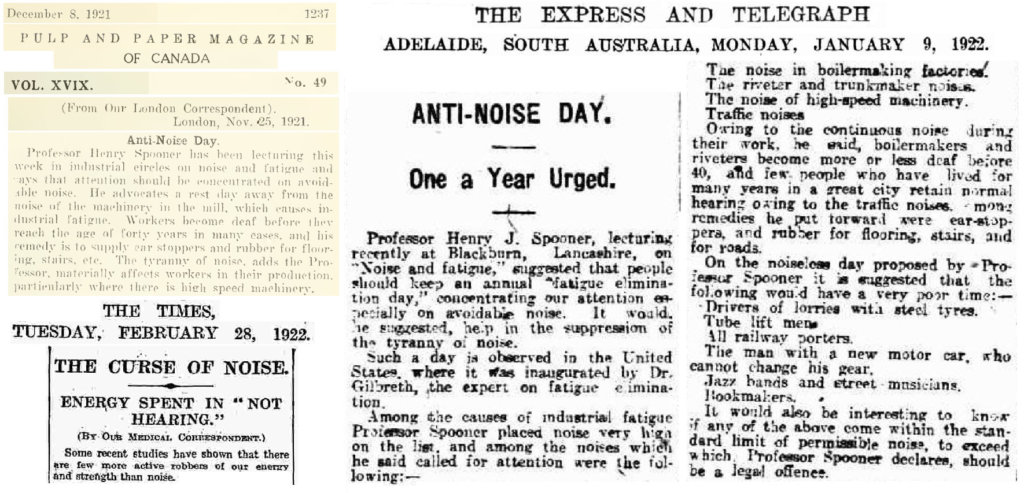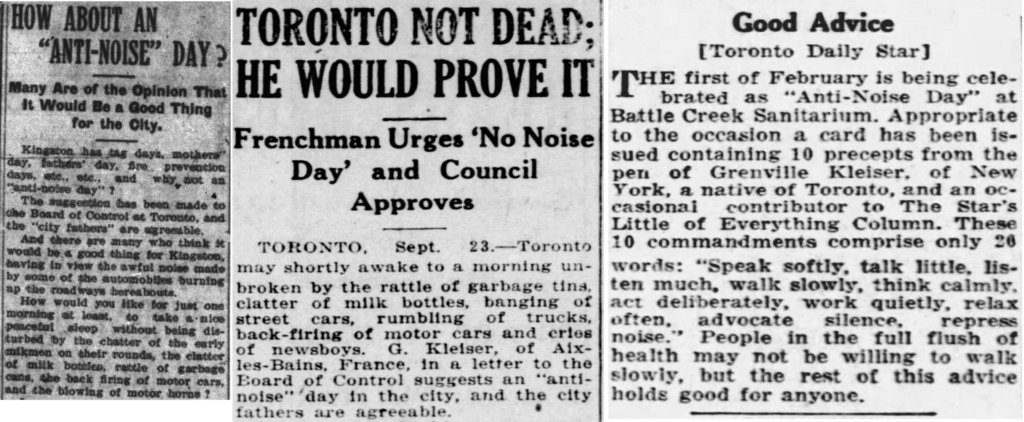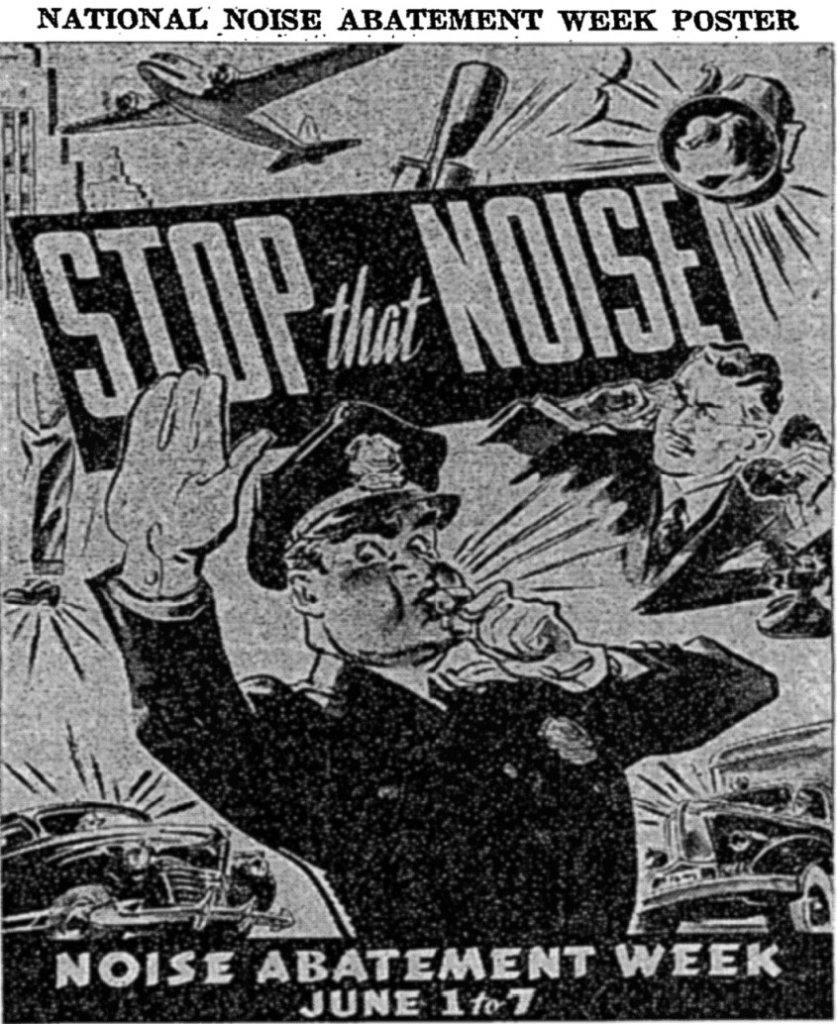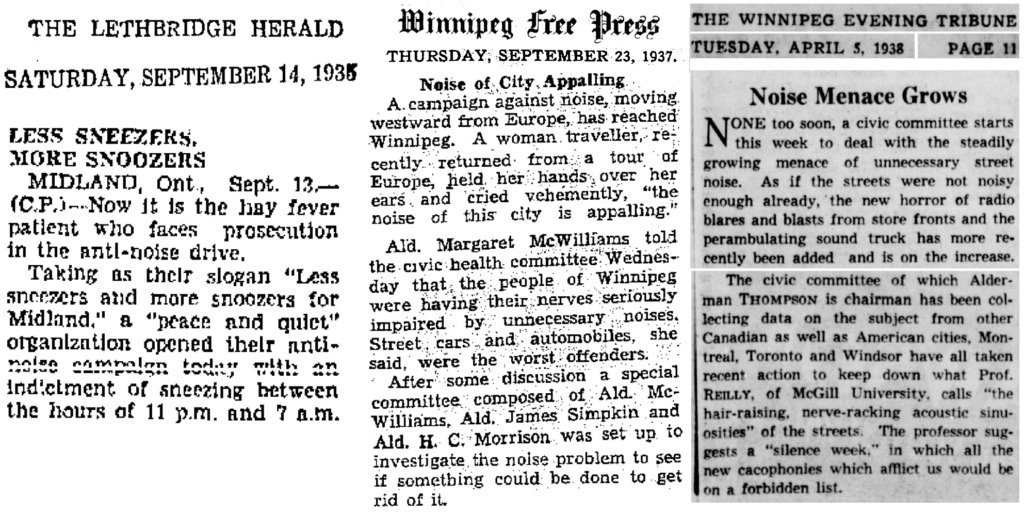The Origin of Anti-Noise Day in the 20th century
Walter Montano
ARQUICUST, Gualeguaychu, Argentina
wmontano@arquicust.com - orcid.org/0000-0002-0059-5257
Introduction
There were some publications in the 19th century which proposed having a “silence week” for mental rest. Also, religious pamphlets recommended having a “week of silence to communicate with God,” it was not until the 20th century, however, that the negative effect of noise on people’s health was seriously considered by medicine and engineering. This article on historical facts on acoustics is centered on noise and health from anti-noise actions between 1921 and 1941, which, in the author’s opinion, stand out from the rest, especially the proposal for an “Anti-Noise Day” each year, to reflect on the health problems rising from ongoing noise exposure.
To write this article, the author has used data which are freely available on Internet and accessible from Argentina, so in the future it shall be possible to add new historical facts by information from a multitude of other sources.
Note. This article is a resumed version of one published in NNI Magazine of the INCE (Montano, 2022).
Henry Spooner and his proposal of 1921
The first suggestion of having a “Day of Silence” or “Anti-noise Day” or similar activity, was in November 1921 by Henry John Spooner (1856-1940), an engineer from England who was dedicated to promoting awareness of noise problems in industry. Spooner took the idea from the “Day of Elimination of Fatigue” that was celebrated every December 5th since 1916 in several U.S. Colleges (Spooner, 1922). His proposal of a day for reflection on noise problems being held annually on a specific date caused great impact in the media for industrial issues (see Figure 1), and it is possible to find many references to having an “Anti-noise Day” at workplaces centered on Spooner’s proposal.

His influential lecture “Health problems involved in noise and fatigue. Rhythms, cadences, periodicities regulate human activities, but noise lessens the aptitude for work” delivered at the Public Hall, Blackburn, Lancashire, England, on November 21, 1921, is available on the Internet (Spooner, 1922).
Grenville Kleiser and his proposal for anti-noise actions
Grenville Kleiser (1868-1935), a Toronto Methodist preacher, suggested an “Anti-Noise Day” in 1926, in which he presented seven steps. The Windsor Star on Sept. 23rd and the Daily British Whig on Sept. 29, 1926, both published some comments having some actions to reduce noise in Toronto, which finally was imposed in 1928, as it was announced in the Windsor Star on Feb. 4th (see Figure 2). Since Kleiser was known for his activities in Europe, he is mistakenly referred to as French or even American. After that early effort, Kleiser published a pamphlet in 1927, sending letters in June to the mayors and media editors of the world’s largest cities, asking for practical cooperation in generating the movement for an Anti-Noise Week. Today, the original Kleiser pamphlet could not be found, but references are given in the article “The power of silence” followed by “held once a year will mean to the community an economic gain in thought, feeling, energy, health, etc.,” ending his suggestion with “The elimination of unnecessary noise does not imply absolute silence or inertia, but greater poise and power to do more efficient work. A crusade against noise is one of the greatest needs of our time” (Editor, 1927).

Early efforts to have an “Anti-noise week” worldwide
In 1927 the London and Paris media ‘voiced’ the implementation of Kleiser’s idea, but only for one day; and there is no mention of the actual implementation of this proposal. In Australia, in 1928, the “Melbourne Noise Abatement League” (MANL), within the “Health Week” organized by the municipality every year, for the first time presented the problems of noise in school children (Montano, 2020). There is a report published in the magazine of the “North Central Association of Colleges and Schools”, in which mention is made of a proposal for an “Anti-noise Week” as an extracurricular educational activity for educational institutions in nineteen US States (North, 1929); this is interesting because in that year the only reference found about the anti-noise week is that of Kleiser, so we could speculate that they were aware of the movement started by him.
“Anti-noise” campaigns around the world
After New York City’s 1930 campaign against urban noise (Thompson, 2002), similar actions were replicated in major cities around the world as anthropogenic noise became more prevalent. In part, this is because listening to music became the only source of free entertainment available to people, because of the 1930s worldwide economic crisis. The second source of noise annoyance was identified as the “abusive” use of car horns. If we consider that in the 1920s and 1930s, newspapers were the main source of information for people, journalists were interested in keeping the attention of readers, so producing “strange news” by press agencies was routine. So, it was possible to read about anti-noise campaigns in distant cities in those years. Since it is established that “anti-noise actions were carried out all over the world,” the author has been published an article in NNI magazine summarizing the anti-noise actions that he could find in newspapers, as examples of the reactions of the media to this issue (Montano, 2022).
The U.S. “Noise Abatement Week”
In the 1940s, a group of professionals from the Acoustical Society of America (ASA) created the “National Noise Abatement Council,” with the purpose of making the population aware of the problems of noise on health (among other issues). Several activities led to the promotion of a “Noise Abatement Week,” suggested to be held once a year. The first year had a modest beginning on October 21st − 28th, 1940, but achieved prominence with the large number of mentions in the press.

The “Noise Abatement Week” was adopted in many U.S. cities, spreading the publicity with a very famous poster at the national level, designed by the National Noise Abatement Council (see Figure 3), which was displayed in over 200 U.S. cities from June 1st - 7th, 1941.
Early Canadian anti-noise actions mentioned in the press
The author has found information on a few Canadian cities concerning anti-noise actions, as the Winnipeg press wrote about many cities (Vancouver and Calgary among them) that have quickly followed London’s lead in putting down unnecessary noise as a menace to public health. The Winnipeg Evening Tribune of Tuesday, September 18, 1934, in a big headline banner announced “Drive against noise in Winnipeg is demanded.” It wasn’t until 1936, though, that some real acts took place between the citizens’ movement and the city councils. The Young Men’s Section of the Board of Trade sponsored the Winnipeg campaign in January 1936, and it was not until September 1937 that activities could be carried out after Alderman Margaret McWilliams (1875-1952) formed a committee. The Hamilton anti-noise campaign was enforced in August 1937. For organizing an anti-noise campaign in Toronto, a sub-committee of the Board of Health of that city called a conference in September 1937.

The author has found that the first actions against noise problems promoted with a scientific point of view was initiated by physics professor Herschel Edward Reilley (1879-1945) of McGill, who presented the paper “Noise Abatement Problems in Canada” at the Ottawa Meeting of the American Association for the Advancement of Science in July 1938, according to the archives at Mc Gill University, Reilley as a governor of the Montreal General Hospital was a chairperson of the Noise Abatement League.
Conclusion
Due to World War II, all international actions against noise that began in the 1930s were interrupted and the acoustic community had to wait decades to coordinate global activities. It is important to promote the Canadian Grenville Kleiser as a pioneer in proposing a day to reflect on the health problems of noise. In Canada, unlike other countries, people concerned with this problem started and led the first social movements against noise, but to date, there is no evidence that anti-noise societies existed before 1940. The author wrote this article based on media published in English and there is a vast amount of data that can be accessed on the Internet, so the author encourages other acousticians to investigate the first anti-noise actions in their cities.
Acknowledgements
The author wishes to thank to Marshall Chain and Alberto Behar of the CanadianAudiologist.ca, for the opportunity to publish this article; also, to Gretel Iorio for assistance with the English proof-reading.
References
Note. Due to each reference weblink being very long, the name of the newspaper and the date are identified in the text, so in order to access any article, please use any search engine.
- Editor (1927) The Power of Silence. Methodist Protestant Herald. Vol.XXXIII(33) p. 5. June 30, 1927. Greensboro, U.S. http://archive.org/details/methodistprotest27meth
- Montano, W. (2020) Montano, W. A. (2020-a) Noise abatement actions in Australasia - 1920s and 30s. Acoustics Australia Vol. 48(2), August 2020. https://link.springer.com/content/pdf/10.1007/s40857-020-00199-x.pdf
- Montano, W.A. (2022) Public concern and measurements of noise in the city. Journal article. Noise/News International. http://noisenewsinternational.net/public-concern-and-measurements-of-noise-in-the-city/
- North (1929). The North Central Association Quarterly. VOL.Ill(4) p.544. March 1929. https://archive.org/details/sim_nca-quarterly_1929-03_3_4?q=%22The+North+Central+Association+Quarterly%22+MARCH%2C+1929
- Spooner, H.J. (1922) Health Problems Involved in Noise and Fatigue. Health in industry. Nation’s Health. Volume IV(2) pp. 91-95. Volume IV(3) pp. 156-159. Chicago, US. https://ia800300.us.archive.org/16/items/nationshealth04chicuoft/nationshealth04chicuoft.pdf
- Thompson, E. (2002) The soundscape of modernity. Architectural Acoustics and the Culture of Listening in America, 1900–1933. The MIT Press. Cambridge, Mass.

